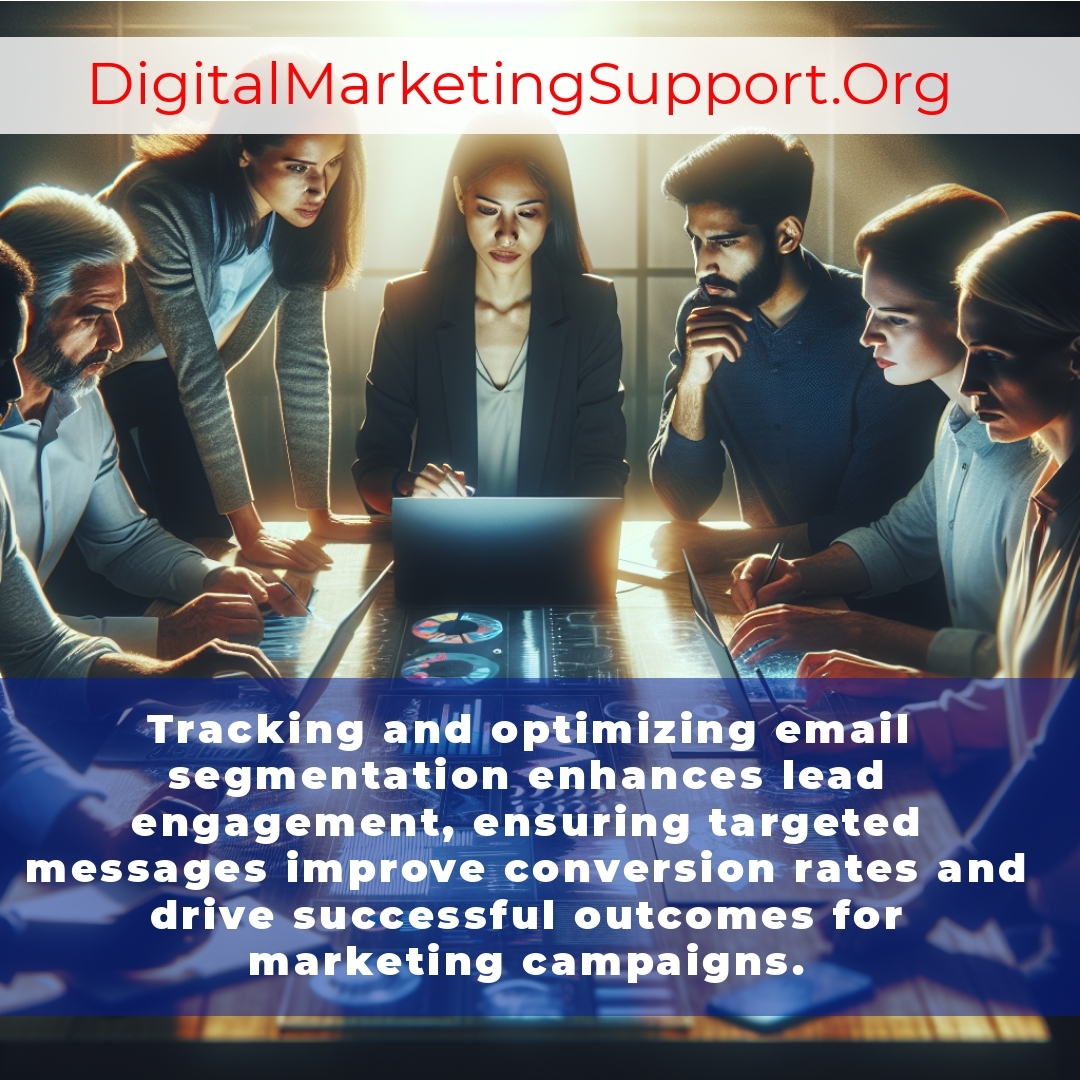Email Segmentation plays a crucial role in enhancing Email Marketing Optimization and implementing effective Lead Success Strategies. By segmenting email lists, marketers can achieve better targeting and engagement, leading to improved open and conversion rates. Understanding its core principles and benefits is essential for driving successful campaigns.
“Tailor your emails; segmentation is key to unlocking engagement.”

Understanding Email Segmentation
Email segmentation is all about dividing your email list into smaller, more targeted groups. By doing this, you can send more relevant content to each group, which leads to better engagement and higher conversion rates. It’s a core principle of email marketing optimization that helps you connect with your audience in a more meaningful way.
What is Email Segmentation?
At its core, email segmentation involves categorizing your subscribers based on specific criteria. This could be anything from demographics to behavior patterns. The main idea is to tailor your messages so that each segment receives content that is most relevant to them.
Benefits of Segmenting Email Lists
Segmenting your email lists comes with a host of benefits. First, it improves email engagement because your subscribers receive content that resonates with their interests and needs. Additionally, it leads to higher conversion rates as targeted emails are more likely to drive action. Personalization is another key advantage, allowing you to create more meaningful connections with your audience.
Key Customer Segmentation Techniques
Demographic Segmentation
Demographic segmentation involves categorizing your audience based on factors like age, gender, location, and income. This technique helps you understand who your customers are and tailor your messages to fit their specific demographic profiles.
Behavioral Segmentation
Behavioral segmentation looks at how customers interact with your brand. This includes their purchase history, website activity, and engagement with previous emails. By analyzing these behaviors, you can create segments that are more likely to respond positively to your campaigns.
Psychographic Segmentation
Psychographic segmentation dives into the interests, values, and lifestyle preferences of your audience. Understanding what motivates your customers on a deeper level allows you to craft messages that truly resonate and foster stronger connections.
Best Practices for Optimizing Email Segmentation
How to Track Email Segmentation Performance
Tracking the performance of your email segmentation is crucial. Start by setting clear goals and using analytics tools to monitor key metrics. Regularly review open rates, click-through rates, and conversion rates to see how each segment is performing.
Best Practices for Optimizing Email Segmentation
To optimize your email segmentation, continuously refine your segments based on performance data. Test different criteria and adjust your segments to improve targeting. Consistently updating your segments ensures that your email marketing remains effective and relevant.
Tools for Measuring Email Segmentation Effectiveness
There are several email analytics tools available that can help you measure the effectiveness of your segmentation. Tools like Mailchimp, HubSpot, and Constant Contact offer robust analytics features that provide insights into how your segments are performing and where improvements can be made.
Strategies for Successful Lead Generation through Email Segmentation
Creating Targeted Email Campaigns
When you create targeted email campaigns, you ensure that each segment receives messages that are specifically designed for their interests and needs. This increases the likelihood of engagement and drives better results for your lead generation efforts.
Tips for Enhancing Email Campaign Targeting
Enhance your email campaign targeting by using personalized subject lines, dynamic content, and tailored offers. Additionally, segment your list based on behavior and preferences to ensure that each email feels relevant and valuable to the recipient.
Tracking and Analyzing Email Performance Metrics
Essential Email Performance Metrics to Monitor
To effectively track your email segmentation performance, focus on key metrics such as open rates, click-through rates, and conversion rates. These metrics provide a clear picture of how well your emails are performing and where adjustments may be needed.
Utilizing Email Analytics Tools to Improve Email Engagement
Email analytics tools are invaluable for improving engagement. By analyzing data from these tools, you can identify trends, understand what’s working, and make informed decisions to enhance your email marketing strategies.
Advanced Email Marketing Optimization Strategies
Personalization and Dynamic Content
Adding personalized elements and dynamic content to your emails can significantly boost engagement. Tailor your messages based on each segment’s preferences and behaviors to create a more personalized experience that resonates with your audience.
Automation in Email Segmentation
Implementing automation in your email segmentation processes can streamline your campaign management. Automated segmentation allows you to dynamically adjust your segments based on real-time data, ensuring that your emails remain targeted and effective without manual intervention.
Improving Email Engagement through Effective Segmentation
Enhancing Content Relevance for Different Segments
To improve email engagement, ensure that the content you send is highly relevant to each segment. Tailor your messages to address the specific needs and interests of each group, making your emails more appealing and engaging.
A/B Testing for Continuous Improvement
Using A/B testing can help you continuously improve your segmented campaigns. Test different subject lines, content formats, and calls to action to see what resonates best with each segment. This ongoing process of testing and refinement leads to better results over time.
Tools and Technologies for Email Segmentation and Optimization
Top Email Analytics Tools
There are several top email analytics tools that can help you track and optimize your email segmentation. Platforms like Mailchimp, HubSpot, and Constant Contact offer comprehensive analytics features that provide detailed insights into your email performance.
Integrating Segmentation Tools with Marketing Platforms
Seamlessly integrating your segmentation tools with existing marketing platforms can enhance your email marketing efforts. By connecting these tools, you can ensure that your segmentation data is always up-to-date and that your campaigns are fully optimized for each segment.
Conclusion
Effective email segmentation is a key driver of lead success and plays a significant role in email marketing optimization. By segmenting email lists, you can achieve better targeting and engagement, leading to higher open and conversion rates. Implementing the right strategies and continuously optimizing your segmentation efforts ensures that your email campaigns remain effective and contribute to sustained business growth.
Remember, successful email segmentation is an ongoing process. Continuously monitor your email performance metrics, refine your segments, and leverage the right tools to maintain and improve your email marketing efforts. With dedication and the right approach, email segmentation can significantly enhance your lead success strategies and overall marketing performance.
What is Email Segmentation?
Email segmentation means dividing your email list into smaller groups based on specific criteria. This can include demographics, customer behavior, or interests. The purpose is to send tailored content that resonates with each group, making your emails more effective.
What are the benefits of segmenting email lists?
- Improved engagement since subscribers receive content that meets their interests.
- Higher conversion rates because targeted emails drive action.
- Enhanced personalization, creating deeper connections with your audience.
What techniques are used for customer segmentation?
- Demographic Segmentation: Involves categorizing by age, gender, location, and income.
- Behavioral Segmentation: Based on how customers interact with your brand, including purchase history and email engagement.
- Psychographic Segmentation: Focuses on interests, values, and lifestyle preferences.
How should I track email segmentation performance?
To track performance, set clear goals and use analytics tools. Regularly review key metrics like open rates, click-through rates, and conversion rates to understand how well each segment is doing.
What are the best practices for optimizing email segmentation?
Continuously refine your segments based on performance data. Test different segmentation criteria and adjust your approach to improve targeting and effectiveness.
Which tools can I use to measure email segmentation effectiveness?
Tools like Mailchimp, HubSpot, and Constant Contact offer analytics features that help track and measure how well your email segments are performing.
How can I create targeted email campaigns?
To create targeted campaigns, ensure each segment receives messages specifically crafted for them, increasing engagement and driving better results.
What tips can enhance email campaign targeting?
- Use personalized subject lines and dynamic content.
- Segment based on customer behavior and preferences.
- Offer tailored promotions to each group.
What email performance metrics should I monitor?
Focus on open rates, click-through rates, and conversion rates to gauge how well your emails are doing and identify areas needing improvement.
How can I utilize email analytics tools for better engagement?
Analyzing data from email analytics tools helps you spot trends, understand what works, and make informed decisions to enhance your email marketing strategies.
How does personalization impact email engagement?
Adding personalized elements and dynamic content can significantly increase engagement. Tailor your messages based on the preferences and behaviors of each segment.
What role does automation play in email segmentation?
Automation streamlines your segmentation process, allowing you to adjust segments dynamically based on real-time data, keeping your emails relevant without manual effort.
How can I improve content relevance for different segments?
Ensure that your emails provide highly relevant content for each segment. Tailor messages to meet the specific needs and interests of each group.
What is A/B testing and how can it improve segmented campaigns?
A/B testing involves comparing different subject lines, content formats, or calls to action to see what resonates best with each segment. This ongoing testing helps improve results over time.
What are the top email analytics tools available?
Some top tools are Mailchimp, HubSpot, and Constant Contact, which offer comprehensive analytics to help you track and optimize your email segmentation.
How can I integrate segmentation tools with marketing platforms?
By integrating your segmentation tools with existing marketing platforms, you ensure that your segmentation data stays current and enhance the efficiency of your email campaigns.








